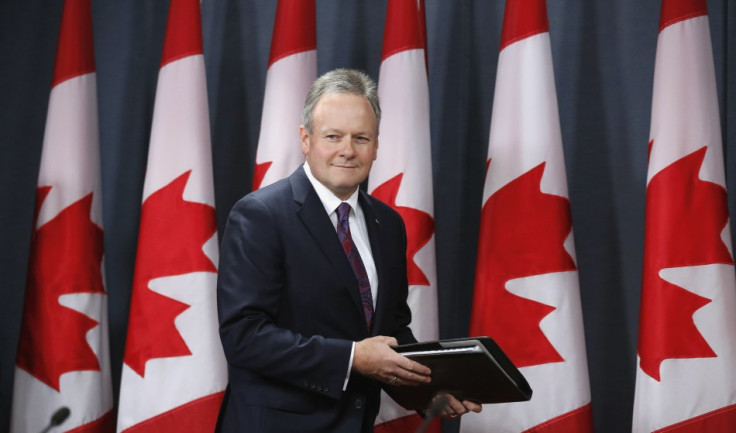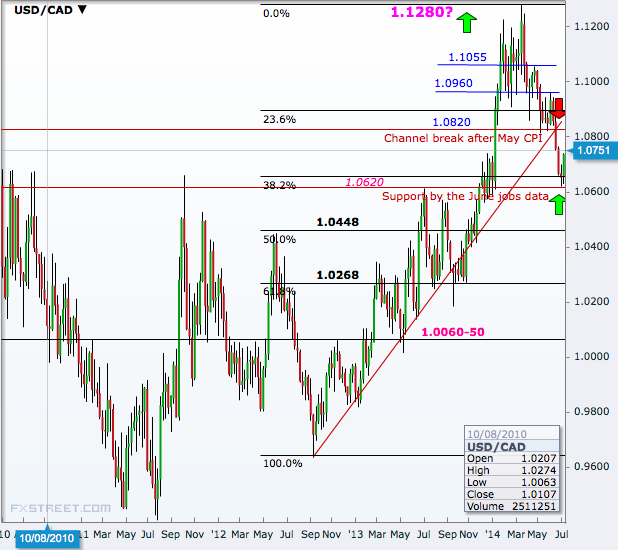Analysis: Why Should BoC Use Strong Words to Talk Down the Loonie?

The Bank of Canada is likely to keep its main policy rate steady at the review on 16 July despite a faster pace of consumer price inflation in the country as the 11 July jobs data has been weak enough to keep the central bank worried about growth.
Moreover, the Canadian dollar's sharper gains after the June policy driven by the quickening inflation will increase risks of a more dovish bias at the BoC this time, and a Federal Reserve that is turning even more growth-concerned these days underpins that case.
That the BoC has been citing the strength of the Canadian dollar as a main constraint on the economy's recovery - of late in the June policy statement and then the 7 July business outlook survey - will also make the loonie bulls worried of bigger losses going forward.
Currency Reaction to Inflation and Jobs Data
The last change in the main BoC rate was the 25 basis points hike in September 2010 that took it to 1%, and the rate has been kept there so far with inflation remaining subdued and growth weak, but the headline CPI measure has risen past the central bank's target of 2% recently.
In the June policy review itself the BoC had noted the acceleration in prices but was also mindful of the downside risks to growth.
"Weighing recent higher inflation readings against slightly increased risks to economic growth leaves the downside risks to the inflation outlook as important as before," BoC said in the 4 June policy statement, referring to the April CPI data.
Inflation further quickened in the next month, data showed on 20 June, but the unexpected loss in employments and a rise in the unemployment rate in May have offset that.
Canada's headline CPI rose to 2.3% in May following a 2% rise in April. The core measure that the central bank considers for policy decisions rose to 1.7% from 1.4%.
USD/CAD had held near the 1.08 support line despite a strongly dovish FOMC on 18 June, but the 20 June Canadian CPI pushed the pair southward with great momentum, helping the loonie touch a six-month high of 1.0618 by 3 July.
This move in the currency showed the importance markets had given to the CPI data, but they have reversed their stance after the 11 July jobs data surprised them on the negative side in a big way.
Canada lost 9,400 jobs in June after adding 25,800 in May while analysts were expecting an increase of 20,000. The unemployment rate rose to 7.1% against the consensus of an unchanged reading of 7%, according to Friday's report.
This added to the GDP data on 30 June that showed the year-over-year growth remaining steady at 0.1% in April, trailing market consensus of a 0.2% expansion.
Exchange Rate And Monetary Policy
The BoC will also be mindful of the strength of the Canadian dollar while setting rates this week.
The June statement showed satisfaction in the exchange rate scenario: "The ingredients for a pickup in exports remain in place, including the lower Canadian dollar and an anticipated strengthening of foreign demand," the central bank noted.
When the June policy was being formulated, the Canadian dollar was up more than 4.4% from the near five-year low of 1.1280 touched in mid-March, but the broader downtrend since September 2012 was still in place.
But the gains in the loonie since the latest inflation data - about 1.9% to the 3 July high - almost threatened to reverse that downtrend, making the central bank intention to bolster growth tougher to be fruitful.
Now with the much weaker jobs data, the market has started selling the currency before the central bank gets the scheduled opportunity to talk it down.
However, the policymakers are likely to word the statement in such a way that the currency weakens further, gets back to its weakening trend, and may even retest the mid-March low near 1.13.
Business Concerns
The business outlook survey by the central bank published on 7 July showed nothing great about the business conditions and also worries about the currency situation.
"On balance, firms expect input prices to rise at a somewhat slower pace than over the past 12 months as upward pressure from the recent depreciation of the Canadian dollar gradually dissipates," according to the report.
"Strong competition continues to restrain expectations for output prices. Inflation expectations are unchanged and remain concentrated in the bottom half of the Bank's inflation-control range," the BoC said.
The Greenback Factor
The task of talking down the Canadian dollar may not be an easy target as the Federal Reserve is in no way getting prepared to change its dovish stance.
Despite a better than expected show in the June non-farm payroll report, the Fed will remain focused on growth, as the world's largest economy has contracted 2.9% in May on an annualised basis. It had expanded 2.6% in April and analysts were expecting a softer reading of -1.7% in the next month, according to the 25 June data.
This makes 15 July testifying by Janet Yellen, the Fed Chair, significant for the Canadian dollar.
If Yellen ignores the US jobs report and some other positive data surprises after the 18 June FOMC and continues to talk about the need to support growth, then the BoC governor Stephen Poloz may have to sound much more dovish when he pens the policy document the next day.
Canada has to fight against the domestic weakness as well as the negative impacts of its big neighbour remaining weak.
USD/CAD Technical Outlook
With the loonie starting its downtrend after Friday's Canadian jobs data, USD/CAD confirmed it has failed to break the 38.2% Fibonacci retracement of the September 2012-March 2014 rally.
Further up, 1.0820 is seen as a strong resistance line, maybe stronger than the 23.6% Fibonacci of 1.0900. The next levels are 1.0960 and 1.1055 ahead of 1.1280, the March peak.
Any failure in breaking through the 1.08 barrier can lead to a turnaround in the pair, and in that case, it has first support at 1.0448, the 50% level.
Further south, USD/CAD will target the 61.8% level of 1.0268 ahead of a stronger line near 1.0060-50.

© Copyright IBTimes 2024. All rights reserved.







